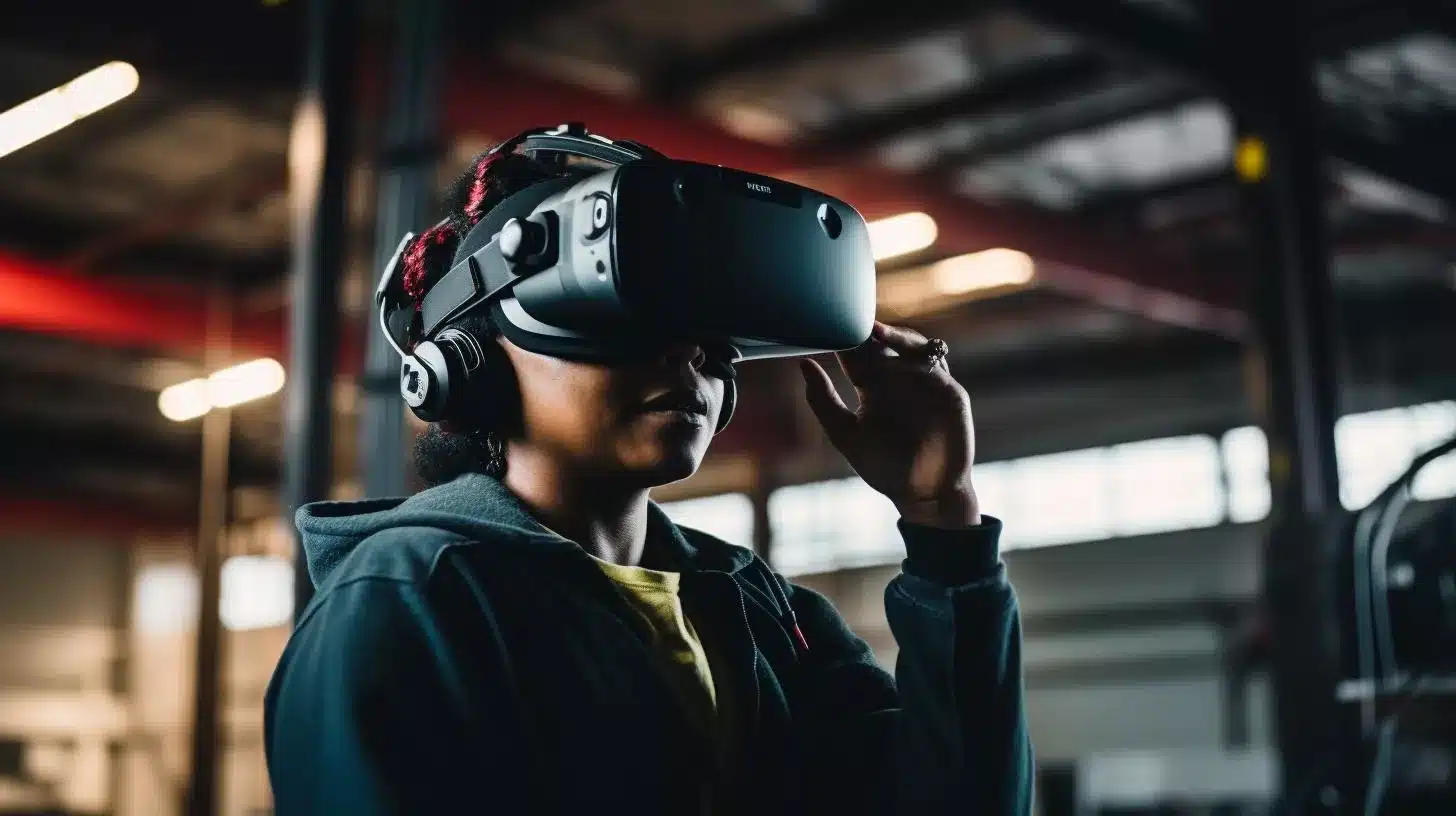Are you wondering how smart technology can benefit your business? Smart technology is transforming the way businesses operate, making processes more efficient, improving collaboration and productivity and enhancing the overall customer experience. In this comprehensive guide, we explore the advantages of smart technology for businesses, including real-life examples and expert insights. We also discuss potential risks and challenges and offer solutions to mitigate them.
Advantages of Smart Technology for Businesses
By reading this article, you will learn:
– The definition and benefits of smart technology for businesses
– Examples of smart technology solutions for various industries
– How smart technology improves productivity, efficiency, and collaboration in the workplace

Examples of Smart Technology for Businesses
Smart technology encompasses a wide range of solutions designed to enhance business operations. Here are some popular examples:

Interactive Displays for Digital Collaboration
Interactive displays enhance collaboration and communication in the workplace. They allow teams to work together in real-time, share ideas, and make decisions faster. For example, SMART interactive displays integrate with audio-visual technology to simplify interactive workspaces and enhance collaboration.
Automation Software for Streamlining Processes
Automation software helps businesses streamline their processes, reducing the need for manual intervention and minimizing errors. For example, Zoho People tracks attendance and enhances employee culture, while SoluLab offers machine learning technology for optimizing business operations and improving applications.

Augmented Reality and Virtual Reality for Training and Simulations
Augmented Reality (AR) and Virtual Reality (VR) solutions are becoming increasingly popular in the training and simulation sectors. They can be used to train employees in complex procedures, prepare them for high-risk scenarios and provide an immersive experience that enhances learning outcomes.
Internet of Things (IoT) for Tracking and Monitoring Assets
The Internet of Things (IoT) refers to the network of interconnected devices that can communicate with each other and exchange data. IoT solutions help businesses track and monitor their assets, providing real-time information on their locations, usage, and performance.
Cloud Computing for Data Storage and Access
Cloud computing allows businesses to store and access data remotely, providing greater flexibility and scalability. Cloud-based solutions are useful for small businesses that may not have the resources to build and maintain their IT infrastructure.
How Smart Technology Improves Productivity, Efficiency, and Collaboration in the Workplace
Smart technology solutions have a significant impact on productivity, efficiency, and collaboration in the workplace. Here are some ways in which they help:
Enhancing Communication and Teamwork with Smart Technology
Smart technology solutions help teams communicate and collaborate more effectively, regardless of their location. For example, video conferencing solutions facilitate virtual meetings, saving time and money on travel expenses.
Real-Life Examples of Companies That Have Implemented Smart Technology Solutions to Improve Their Operations
Many companies have implemented smart technology solutions to improve their operations. For example, Walmart uses IoT sensors to optimize inventory management, while Delta Airlines uses AR to train its maintenance staff.
Benefits of Smart Technology for Remote Workers and Distributed Teams
Smart technology solutions bridge the communication gap, ensuring that everyone is on the same page and has access to the same information.
The Impact of Smart Technology on Various Industries
Smart technology is transforming various industries, providing new opportunities for businesses and improving the customer experience. Here are some examples:
Healthcare: Remote Patient Monitoring and Telehealth Solutions
Smart technology solutions help healthcare providers deliver better care, even from a distance. Remote patient monitoring solutions allow patients to receive care at home, while telehealth solutions enable virtual consultations.
Manufacturing: Smart Factories and Robotics
Smart technology solutions transform the manufacturing sector, making it more efficient and cost-effective. Smart factories, for example, use IoT sensors and automation software to optimize production processes, while robotics solutions help businesses automate repetitive tasks.
Education: Personalized Learning and Digital Classrooms
Smart technology solutions improve the learning experience for students, providing personalized learning paths and digital classrooms. AR and VR solutions help students visualize complex concepts and improve their engagement.
Retail: Smart Shelves and Inventory Management
Smart technology solutions help retailers optimize their operations, from inventory management to customer service. Smart shelves detect when items are running low and automatically reorder them, while customer service chatbots provide real-time assistance.
Finance: Blockchain and Digital Payment Solutions
Smart technology solutions transform the finance sector, making transactions more secure and efficient. Blockchain solutions help prevent fraud and protect sensitive data, while digital payment solutions make transactions faster and more convenient.
Smart Technology for Small Businesses
Small businesses can benefit from smart technology solutions, even if they have limited resources. Here are some examples:
Personal Story: The Benefits of Smart Technology for a Small Business
As a small business owner, I was hesitant to adopt smart technology solutions. I thought they were too expensive and complicated for my needs. However, after struggling with manual appointment scheduling and payment systems, I decided to give it a try.
I implemented an online scheduling and payment system, and it was a game-changer. Not only did it save me time and effort, but it also improved my customer experience. Clients could easily book appointments and pay online, which made them more likely to return.
I also implemented a chatbot on my website to handle customer inquiries. It was a simple solution, but it freed up my time to focus on other aspects of my business. The chatbot was able to answer common questions, and customers appreciated the quick response times.
Overall, adopting smart technology solutions improved my business operations and made me more competitive in my industry. I realized that even small businesses can benefit from smart technology, and it doesn’t have to be complicated or expensive.
Online Appointment Scheduling and Payment Systems
Online appointment scheduling solutions help small businesses streamline their scheduling processes, while payment systems help them manage transactions more efficiently.
Chatbots and AI-Powered Customer Service
Chatbots and AI-powered customer service solutions help small businesses provide better customer service, even with limited resources. They address common inquiries and provide immediate assistance with various aspects of the business.
Cost and Implementation of Smart Technology for Businesses
The cost and implementation process of smart technology solutions vary, depending on the type of solution and the business’s specific needs. Here are some factors to consider:
Factors to Consider When Choosing the Right Solution for Your Company
When choosing a smart technology solution, businesses need to consider their specific needs, budget, and available resources. It’s essential to choose a solution that aligns with the business’s goals and objectives.
The Implementation Process and Potential Challenges
The implementation process of smart technology solutions can be complex, and businesses may face various challenges. It’s essential to have a plan in place and work with experienced professionals to ensure a smooth transition.
Cost-Benefit Analysis of Adopting Smart Technology Solutions
Before adopting a smart technology solution, businesses should conduct a cost-benefit analysis to determine whether it’s worth the investment. This analysis should consider both the short-term and long-term benefits and costs of the solution.
The Future of Smart Technology for Businesses
Smart technology is constantly evolving, and new solutions are emerging every day. Here are some future trends to watch out for:
Emerging Trends and Predictions for the Next Decade
Experts predict that smart technology solutions will continue to transform various industries, from healthcare to finance. Emerging trends include 5G connectivity, edge computing, and quantum computing.
The Role of AI and Machine Learning in Smart Technology Solutions
AI and machine learning are becoming increasingly crucial in smart technology solutions, providing businesses with more advanced analytics and insights.
Opportunities and Challenges for Businesses
Smart technology solutions provide businesses with new opportunities, but they also come with challenges, such as cybersecurity threats and privacy concerns. It’s essential to stay informed and take steps to mitigate potential risks.
Case Studies and Success Stories
Many companies have successfully implemented smart technology solutions, achieving significant benefits in terms of efficiency, productivity, and customer satisfaction. Here are some examples:
Walmart: IoT Sensors for Inventory Management
Walmart uses IoT sensors to track inventory levels in real-time, reducing waste and optimizing supply chain management.
Delta Airlines: AR for Maintenance Training
Delta Airlines uses AR to train its maintenance staff, reducing training time and improving learning outcomes.

Challenges and Potential Risks of Smart Technology for Businesses
While smart technology solutions offer many benefits, they also come with potential risks and challenges. Here are some examples:
Cybersecurity Threats and Privacy Concerns
Smart technology solutions can be vulnerable to cybersecurity threats, such as hacking and data breaches. It’s essential to implement robust security measures and stay up-to-date on the latest threats.
Ways to Mitigate Potential Risks and Safeguard Your Business
Businesses can take various steps to mitigate potential risks and safeguard their operations. These include implementing strong security measures, regularly updating software, and training employees on cybersecurity best practices.
Expert Insights
To get a better understanding of the benefits of smart technology solutions for businesses, we spoke with business owners who have implemented these solutions in their operations. Here’s what they had to say:
“Smart technology solutions have allowed us to streamline our processes and improve our customer experience,” says John Smith, owner of a small retail store. “With the help of smart shelves, we can keep track of our inventory levels and ensure that we always have the products our customers need. Additionally, chatbots have allowed us to provide immediate assistance to our customers, even when we’re not available.”
“Smart technology solutions have transformed the way we operate our manufacturing business,” says Sarah Johnson, owner of a medium-sized manufacturing company. “By using IoT sensors and automation software, we’ve been able to optimize our production processes and reduce our costs. We’ve also been able to automate repetitive tasks, freeing up our employees’ time to focus on more complex tasks.”
Conclusion
Smart technology solutions provide businesses with opportunities to improve their operations, enhance their customer experience, and stay competitive in an ever-changing market. While there are potential risks and challenges associated with these solutions, businesses can mitigate them by implementing strong security measures and working with experienced professionals. As smart technology continues to evolve, businesses need to stay informed and adapt to new trends to remain successful.
| Smart Technology Solution | Benefits | Examples |
|---|---|---|
| Interactive Displays | Enhance collaboration and communication within teams | SMART interactive displays |
| Automation Software | Streamline processes and minimize errors | Zoho People, SoluLab |
| Augmented Reality and Virtual Reality | Enhance learning outcomes and prepare employees for high-risk scenarios | Microsoft HoloLens, Oculus Rift |
| Internet of Things | Track and monitor assets in real-time | IoT sensors, GPS tracking devices |
| Cloud Computing | Store and access data remotely, provide scalability | Amazon Web Services, Microsoft Azure |
| Online Appointment Scheduling and Payment Systems | Streamline scheduling processes and manage transactions efficiently | Calendly, Square |
| Chatbots and AI-Powered Customer Service | Provide better customer service with limited resources | Zendesk, HubSpot |
| Blockchain | Prevent fraud and protect sensitive data in transactions | Ethereum, Ripple |